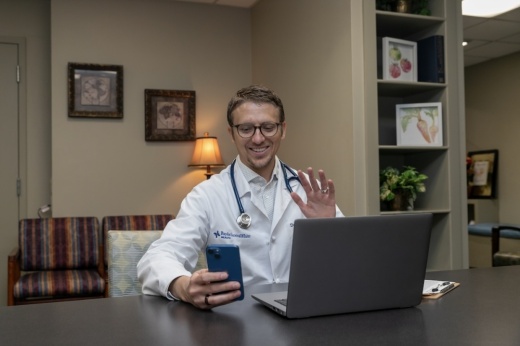Local providers across Austin saw telehealth explode during the COVID-19 pandemic; however, virtual health care continues to be a popular option for some as in-person visits have resumed. In Texas, 75% of doctors use telemedicine for at least 1 in 10 patient visits, according to the Texas Medical Association.
South Austin resident Barbara Dinoff said she first started using telehealth in 2021 after Winter Storm Uri forced the closure of her doctor’s office. Just a few weeks postpartum, Dinoff was able to see her doctor virtually to check in.
Today, Dinoff uses telemedicine for routine check-ins with her mental health provider.
“For something like getting a quick prescription refill, I just really don’t think it’s worth the hour-and-a-half [drive] for the three-minute health care visit,” she said.
Telehealth has become incorporated in a variety of aspects within health care, spanning from routine follow-ups and run-of-the-mill cold and flu symptoms to mental health visits and long-term chronic disease care.
The big picture
Dr. Pallavi Mukkamala, a family practitioner at the Baylor Scott and White Clinic in Southwest Austin, said that as the technology has evolved, it has become easier for all of her patients to utilize telehealth as an appointment option. Mukkamala works as a family practitioner seeing anyone from infants to seniors.
“Telehealth has really become hand-in-hand with in-person visits,” Mukkamala said. “... Before the pandemic, a lot of us never really did much telemedicine, so it pushed us into it in a hurry. But once it was here, we all realized how convenient it was and how simple it is. It’s stayed, and the demand for it has not gone down.”
Mukkamala said providers have adapted diagnostic approaches for minor or routine issues. Instead of a visit, they might ask patients to send close-up photos of skin conditions or other visible concerns.
Additionally, clinics like Baylor Scott and White offer 24-hour virtual urgent care, providing late-night care and answers.
The impact
Studies suggest telemedicine can lower barriers for obtaining mental health and specialty care.
The most common type of diagnosis for clients receiving telehealth services are related to mental, behavioral and neurodevelopmental disorders, according to a Texas Health and Human Services department 2024 report.
Patients of Dr. Victor H. Gonzalez Montoya, a neurologist with Baylor Scott & White who specializes in epilepsy, use telehealth visits due to limitations of the disease.
The Austin-based specialist sees patients from across Texas. He noted there are too few neurologists to meet the state’s needs, and demand for neurological care continues to grow as the population ages.
Additionally, hospitals have been able to utilize telemedicine to call in specialist doctors in life-threatening situations, such as stroke acute care treatment, another subspecialty in neurology.
Another Angle
Alternatively, Dr. Mark Ambler, associate medical director for primary care and family medicine physician at Austin Regional Clinic in Southwest Austin, said that increasingly more patients are wanting to be seen in-person.
“I’d say about 10% of our visits are telehealth right now—it’s a relatively small number compared to where we were four years ago. But most people are wanting to come back in,” Ambler said.
Ambler explained that telehealth can be a “convenient” tool for both the patient and the provider, especially when trying to be seen for minor issues quickly, but that sometimes being seen in person is necessary.
“[When] somebody does a telehealth visit for ear pain. I really don’t know what to do with that. If I can’t examine their ear, it’s really hard to figure out what’s going on,” he said.
A survey conducted by the Texas Medical Association in January found the top reasons for the roughly 9% decline in telehealth visits over the past two years was due to patients’ preference to be seen in-office as well as technological limitations.
“I don’t generally like it for something like a primary care visit, having a cold or something like that. I just feel more comfortable [being seen] in person, especially just knowing that there might be a follow-up test that I’ll have to go in-person for anyway,” Dinoff said.
For certain symptoms—such as those of strep throat, which may require an in-person throat swab test to determine care needed—patients are often better served by coming in-person for an office visit, Mukkamala said.
Food for thought
Telehealth visits are often reimbursed by insurance companies at around 85% of a regular visit after the federal COVID-19 public health emergency ended in 2023, Ambler said, adding that these rates are still much higher than pre-pandemic.
Reimbursement rates affect both how much the doctor is paid for providing the service and how much a patient is liable for. However, actual rates can fluctuate between different policy types and coverage providers.
Gonzalez Montoya remained optimistic that, in time, payment for telehealth services would reach a more equitable and consistent level.
For patients with recurring needs for follow-up care, researchers at The University of Texas at Austin found that telehealth visits can reduce the number of future outpatient visits for several chronic diseases by roughly 14%, equal to a reduction of $239 in total cost within a month after an emergency room visit.





